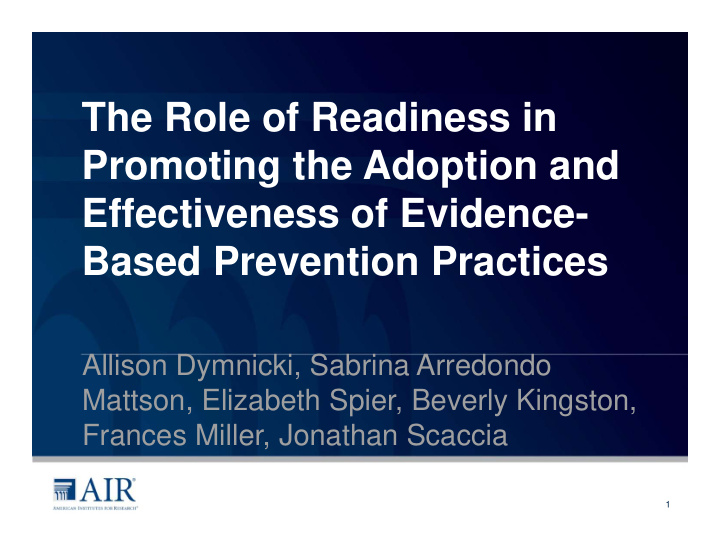



The Role of Readiness in Promoting the Adoption and Effectiveness of Evidence- Based Prevention Practices Allison Dymnicki, Sabrina Arredondo Mattson, Elizabeth Spier, Beverly Kingston, Frances Miller, Jonathan Scaccia 1
Acknowledgements Agenda A MERICAN I NSTITUTES FOR R ESEARCH 2
Overview Agenda • Overview of key components of readiness • Description of Safe Communities Safe Schools model and evaluation design • Preliminary readiness findings A MERICAN I NSTITUTES FOR R ESEARCH 2
Key Components of Readiness Agenda Dymnicki, Wandersman, Osher, Grigorescu, V., & Huang, 2014 A MERICAN I NSTITUTES FOR R ESEARCH 2
Agenda Readiness Assumptions A MERICAN I NSTITUTES FOR R ESEARCH 2
Agenda Readiness Assumptions A MERICAN I NSTITUTES FOR R ESEARCH 2
Safe Communities Safe Schools (SCSS) Agenda A MERICAN I NSTITUTES FOR R ESEARCH 2
A Comprehensive Framework A MERICAN I NSTITUTES FOR R ESEARCH
SCSS Logic Model 9 A MERICAN I NSTITUTES FOR R ESEARCH
Evaluation Design and Sample Staggered entry randomized control trial with 46 Colorado Schools to address if the model: 1. Is implemented as intended 2. Effective when implemented as intended A MERICAN I NSTITUTES FOR R ESEARCH 10
Methods Two-step readiness approach 1. Readiness feasibility visits 2. Comparison of scores on 90-item Readiness Monitoring Tool (Wandersman & Scaccia, 2017) completed annually by school-based team members A MERICAN I NSTITUTES FOR R ESEARCH 11
Readiness Assessment Results: Year 1 & 2 Step 1: 46 of 60 schools met readiness criteria and agreed to participate Step 2: Schools report (at onset) having a champion that supports the SCSS model The SCSS model is compatible with schools’ values and norms Schools enjoy implementing the SCSS model Leadership support increased Prioritizing the SCSS model increased Supportive climate for the SCSS model increased A MERICAN I NSTITUTES FOR R ESEARCH 12
Implications • Determining the ideal type of schools to partner with on comprehensive school change efforts • Understanding how to foster components of readiness and which components can be strengthened through training and technical assistance • Thinking through how we do this work without increasing disparities A MERICAN I NSTITUTES FOR R ESEARCH 13
Next Steps • Explore how the readiness data (both overall levels and changes in readiness components) relates to fidelity of implementation data • Explore sequential relationship of readiness to implementation to targeted outcomes • Explore which aspects of readiness are malleable for schools that don’t begin “ready” A MERICAN I NSTITUTES FOR R ESEARCH 14
Thank You! Allison Dymnicki adymnicki@air.org 270 768-7063
References • Dymnicki, A., Wandersman, A., Osher, D., Grigorescu, V., & Huang, L. (2014). Willing, Able à Ready: Basics and Policy Implications of Readiness as a Key Component For Implementation of Evidence- Based Practices . Washington, DC: American Institutes for Research. • Kingston, B., Arredondo Mattson, S., Dymnicki, A., Spier, E., Fitzgerald, M., Shipman, K., Goodrum, S. et al. (2018) Building schools’ readiness to implement a comprehensive approach to school safety. Clinical Child and Family Psychology Review 21 (4): 433-449. • Wandersman, A., & Scaccia, J. (2017). Organizational readiness: Measurement and as a predictor of progress: Final Report. Prepared for the Robert Wood Johnson Foundation. Award # 35497. A MERICAN I NSTITUTES FOR R ESEARCH 16
Recommend
More recommend